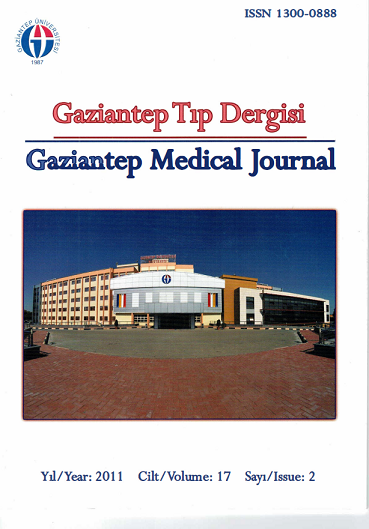Ultrasound-guided regional anesthesia for orthopedic surgery in pediatric patients
Ortopedik cerrahi için pediatrik hastalarda ultrason klavuzluğunda rejyonal anestezi
DOI:
https://doi.org/10.5455/GMJ-30-2011-33Keywords:
Orthopedic surgery, pediatric, regional anesthesia, ultrasoundAbstract
Introduction of the use of ultrasound (US) has led to very important developments in pediatric regional anesthesia and made applications, which are hard or even impossible to perform, applicable by the guidance of US. In this study, we aimed to discuss USguided peripheral nerve and plexus blocks that we made for intraoperative anesthesia, analgesia or postoperative analgesia in 81 pediatric patients ranging from ages 1 to 16 who were operated in the last year. For this study, anesthesia forms, evaluation forms of regional anesthesia, observation forms for nurses, and hospital epicrises of patients were used. Demographic data (age, sex, weigh, height), ASA scores, anesthetic properties, postoperative duration of analgesia and motor block and complications of patients were recorded. Estimated mean duration of analgesia for upper and lower extremities were 5.8 ± 1.6 h, and 8.7 ± 2.5 h, respectively, the duration of motor block for upper and lower extremities were 3.6 ± 0.7 h, 5.3 ± 1.8 h, respectively. Failed or insufficient block count was three. In orthopedic surgery applied pediatric patients US-guided regional blocks can be applied effectively and safely and it has high achievement and minimal complication rates.
Metrics
References
Marhofer P, Chan VW. Ultrasound-guided regional anesthesia: current concepts and future trends. Anesth Analg 2007;104(5):1265-9.
Marhofer P, Frickey N. Ultrasonographic guidance in pediatric regional anesthesia. Part 1. Theoretical background. Paediatr Anaesth 2006;16(10):1008-18.
Roberts S. Ultrasonographic guidance in pediatric regional anesthesia. Part 2. Techniques. Paediatr Anaesth 2006;16(11):1112-24.
Jan van Geffen G, Tielens L, Gielen M. Ultrasound-guided interscalene brachial plexus block in a child with femur fibula ulna syndrome. Paediatr Anaesth 2006;16(3):330-2.
Somri M, Tome R, Yanovski B, Asfandiarov E, Carmi N, Mogilner J, et al. Combined spinal-epidural anesthesia in major abdominal surgery in high-risk neonates and infants. Pediatr Anesth 2007;17(11):1059-65.
Suresh S, Barcelona SL, Young NM, Seligman I, Heffner CL, Coté CJ. Postoperative pain relief in children undergoing tympanomastoid surgery: is a regional block better than opioids? Anesth Analg 2002;94(4):859-62.
Splinter WM, Semelhago LC, Chou S. The reliability and validity of a modified CHEOPS pain score. Anesth Analg 1994;78(2S):S413.
Willschke H, Marhofer P, Bösenberg A, Johnston S, Wanzel O, Cox SG, et al. Ultrasonography for ilioinguinal/iliohypogastric nerve blocks in children. Br J Anaesth 2005; 95(2):226-30.
Marhofer P, Sitzwohl C, Greher M, Kapral S. Ultrasound guidance for infraclavicular brachial plexus anaesthesia in children. Anaesthesia 2004;59(7):642-6.
Rapp HJ, Grau T. Ultrasound-guided regional anesthesia in pediatric patients. Tech Reg Anesth Pain Manage 2004;8:179- 98.
Giaufre´ E, Dalens B, Gombert A. Epidemiology and morbidity of regional anaesthesia in children. a one-year prospective survey of the French-Language Society of Pediatric Anesthesiologists. Anesth Analg 1996;83(5):904-12.
Schafhalter-Zoppoth I, Gray AT. Ultrasound-guided unlar nerve block in the presence of a superficial ulnar artery. Reg Anesth Pain Med 2004;29(3):297-8.
Marhofer P, Greher M, Kapral S. Ultrasound guidance in regional anaesthesia. Br J Anaesth 2005;94(1):7-17.
Zetlaoui PJ, Labbe JP, Benhamou D. Ultrasound guidance for axillary plexus block does not prevent intravascular injection. Anesthesiology 2008;108(4):761.
Loubert C, Williams SR, Helie F, Arcand G. Complication during ultrasound-guided regional block: accidental intravascular injection of local anesthetic. Anesthesiology 2008;108(4):759-60.
Schwemmer U, Markus CK, Greim CA, Brederlau J, Trautner H, Roewer N. Sonographic imaging of the sciatic nerve and its division in the popliteal fossa in children. Pediatr Anesth 2004; 14(12):1005-8.
Oberndorfer U, Marhofer P, Bösenberg A, Willschke H, Felfernig M, Weintraud M, et al. Ultrasonographic guidance for sciatic and femoral nerve blocks in children. Br J Anaesth 2007;98(6):797-801.
Ponde VC, Desai AP, Dhir S. Ultrasound-guided sciatic nerve block in infants and toddlers produces successful anesthesia regardless of the motor response. Paediatr Anaesth 2010;20(7):633-7.
Willschke H, Bösenberg A, Marhofer P, Johnston S, Kettner S, Eichenberger U, et al. Ultrasonographic-guided ilioinguinal/iliohypogastric nerve block in pediatric anesthesia: what is the optimal volume? Anesth Analg 2006;102(6):1680- 4.
Weintraud M, Lundblad M, Kettner SC, Willschke H, Kapral S, Lönnqvist PA, et al. Ultrasound versus landmark-based technique for ilioinguinal-iliohypogastric nerve blockade in children: the implications on plasma levels of ropivacaine. Anesth Analg 2009; 108(5):1488-92.
Vas L. Continuous sciatic block for leg and foot surgery in 160 children. Paediatr Anaesth 2005;15(11):971-8.
Sandhu NS, Sidhu DS, Capan LM. The cost comparison of infraclavicular brachial plexus block by nerve stimulator and ultrasound guidance. Anesth Analg 2004; 98(1):267-8.
Downloads
Published
How to Cite
Issue
Section
License
Copyright (c) 2023 European Journal of Therapeutics

This work is licensed under a Creative Commons Attribution-NonCommercial 4.0 International License.
The content of this journal is licensed under a Creative Commons Attribution-NonCommercial 4.0 International License.


















